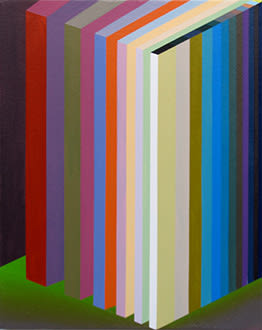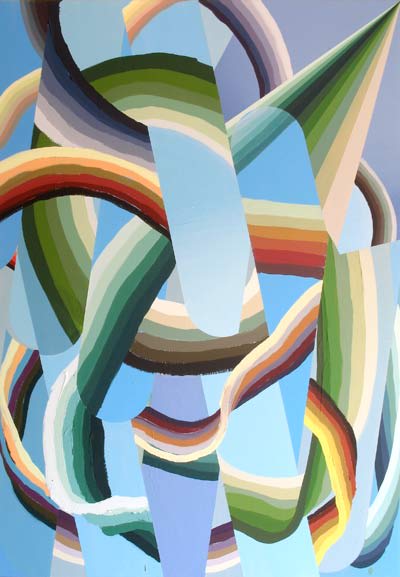Bryan Spier: Expandable Paintings
In the J.G. Ballard story The Overloaded Man, Faulkner, the man of the title, while going through a sort of mid-life crisis, teaches himself to forget to interpret what he can see, except for the most basic properties of light and movement. The story describes how Faulkner, with eyes unfocussed and fingers in his ears, escapes into a blissful, silent communion with a moving mass of coloured light.
This must be like being an infant again, to perceive the world before being able to understand it as an accumulation of spaces and objects. Or when a person is cured of blindness - Merleau-Ponty writes about someone like that who sees their own arm as a white patch floating in front of them, or another who, having been blind for eighteen years, tries to touch a ray of sunlight as if it were a solid thing. Using sight without knowing how is like using it as you would the sense of touch, your eyes 'feeling' their way over an endless unbroken surface of colour.
A version of this can be approximated by directing the line of sight from each eye to its extreme periphery. This causes the visual field to bulge and expand; it's like too much information is overloading the brain's power to perceive depth and delineate objects. While expanding, the field blurs and flattens out, making your eyes water and sting. The substance and meaning of the things you see weakens and retreats behind base optical stimulation.
Likewise, Faulkner feels the world 'nagging' at him with its significance - the aim of his experiment is to simply shut it off by ignoring everything except that pure experience of sight; to escape into himself and at the same time away from his body, to feel himself 'suspended like an image floating on a sea of ideation.' And it is true, a strange property of seeing is that the more we concentrate on the physical machinery of it, the more disembodied we begin feel.
The point is that everyday unthinking sight reveals a familiar world, full of meaningful but generic, miscellaneous things; like the outlines and fragments of umbrellas, traffic cones, road signs, pipes, ribbons and pie graphs in Spier's paintings. But the paintings are also thin slabs of luminous colour that only suggest something tangible. They act like revolving doors between the dreamy, solipsistic experiences written about in Ballard's story, or the revelations of the once-again-sighted who rediscover what density and distance can look like while they go about 'feeling' their way through a textureless colour field, and the routine apprehension of ordinary things.
The compositions of simple silhouettes, segments and bars indicating volume, gradients and geometric shapes do this by trying to subtly offend those overly familiar habits of perception. For example: by stretching a line just far enough so the area it traces falls over somewhere between figure and ground, or by dividing up the space of the picture into an awkward, incomprehensible overlapping of vertical tubes and little off-centre diagonal ledges, or by dragging a brush across a set of clean hard lines like muddy boots on freshly mopped tiles, Spier's paintings want to sort of demoralise that learned behaviour - to make the way seeing works appear both beautifully obvious and animally stupid.
Michael Ascroft








